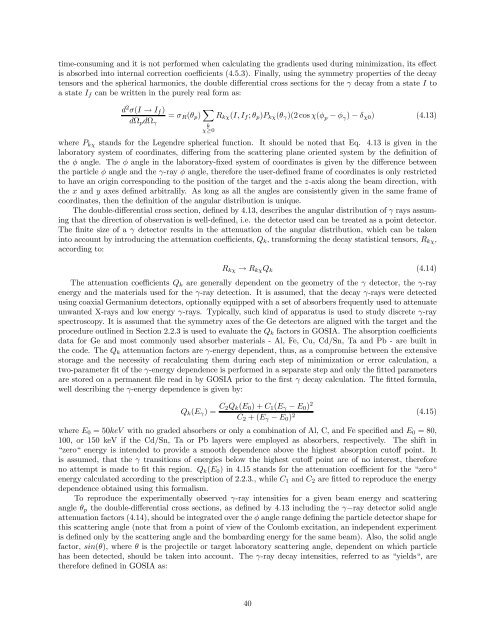coulomb excitation data analysis codes; gosia 2007 - Physics and ...
coulomb excitation data analysis codes; gosia 2007 - Physics and ...
coulomb excitation data analysis codes; gosia 2007 - Physics and ...
Create successful ePaper yourself
Turn your PDF publications into a flip-book with our unique Google optimized e-Paper software.
time-consuming <strong>and</strong> it is not performed when calculating the gradients used during minimization, its effectis absorbed into internal correction coefficients (4.5.3). Finally, using the symmetry properties of the decaytensors <strong>and</strong> the spherical harmonics, the double differential cross sections for the γ decay from a state I toastateI f can be written in the purely real form as:d 2 σ(I → I f )dΩ p dΩ γ= σ R (θ p ) X R kχ (I,I f ; θ p )P kχ (θ γ )(2 cos χ(φ p − φ γ ) − δ χ0 ) (4.13)kχ≥0where P kχ st<strong>and</strong>s for the Legendre spherical function. It should be noted that Eq. 4.13 is given in thelaboratory system of coordinates, differing from the scattering plane oriented system by the definition ofthe φ angle. The φ angle in the laboratory-fixed system of coordinates is given by the difference betweenthe particle φ angle <strong>and</strong> the γ-ray φ angle, therefore the user-defined frame of coordinates is only restrictedto have an origin corresponding to the position of the target <strong>and</strong> the z-axis along the beam direction, withthe x <strong>and</strong> y axes defined arbitralily. As long as all the angles are consistently given in the same frame ofcoordinates, then the definition of the angular distribution is unique.The double-differential cross section, defined by 4.13, describes the angular distribution of γ rays assumingthat the direction of observation is well-defined, i.e. the detector used can be treated as a point detector.The finite size of a γ detector results in the attenuation of the angular distribution, which can be takeninto account by introducing the attenuation coefficients, Q k , transforming the decay statistical tensors, R kχ ,according to:R kχ → R kχ Q k (4.14)The attenuation coefficients Q k are generally dependent on the geometry of the γ detector, the γ-rayenergy <strong>and</strong> the materials used for the γ-ray detection. It is assumed, that the decay γ-rays were detectedusing coaxial Germanium detectors, optionally equipped with a set of absorbers frequently used to attenuateunwanted X-rays <strong>and</strong> low energy γ-rays. Typically, such kind of apparatus is used to study discrete γ-rayspectroscopy. It is assumed that the symmetry axes of the Ge detectors are aligned with the target <strong>and</strong> theprocedure outlined in Section 2.2.3 is used to evaluate the Q k factors in GOSIA. The absorption coefficients<strong>data</strong> for Ge <strong>and</strong> most commonly used absorber materials - Al, Fe, Cu, Cd/Sn, Ta <strong>and</strong> Pb - are built inthe code. The Q k attenuation factors are γ-energy dependent, thus, as a compromise between the extensivestorage <strong>and</strong> the necessity of recalculating them during each step of minimization or error calculation, atwo-parameter fit oftheγ-energy dependence is performed in a separate step <strong>and</strong> only the fitted parametersarestoredonapermanentfile read in by GOSIA prior to the first γ decay calculation. The fitted formula,well describing the γ-energy dependence is given by:Q k (E γ )= C 2Q k (E 0 )+C 1 (E γ − E 0 ) 2C 2 +(E γ − E 0 ) 2 (4.15)where E 0 =50keV with no graded absorbers or only a combination of Al, C, <strong>and</strong> Fe specified <strong>and</strong> E 0 =80,100, or 150 keV if the Cd/Sn, Ta or Pb layers were employed as absorbers, respectively. The shift in“zero“ energy is intended to provide a smooth dependence above the highest absorption cutoff point. Itis assumed, that the γ transitions of energies below the highest cutoff point are of no interest, thereforeno attempt is made to fit this region. Q k (E 0 ) in 4.15 st<strong>and</strong>s for the attenuation coefficient for the “zero“energy calculated according to the prescription of 2.2.3., while C 1 <strong>and</strong> C 2 are fitted to reproduce the energydependence obtained using this formalism.To reproduce the experimentally observed γ-ray intensities for a given beam energy <strong>and</strong> scatteringangle θ p the double-differential cross sections, as defined by 4.13 including the γ−ray detector solid angleattenuation factors (4.14), should be integrated over the φ angle range defining the particle detector shape forthis scattering angle (note that from a point of view of the Coulomb <strong>excitation</strong>, an independent experimentis defined only by the scattering angle <strong>and</strong> the bombarding energy for the same beam). Also, the solid anglefactor, sin(θ), whereθ is the projectile or target laboratory scattering angle, dependent on which particlehas been detected, should be taken into account. The γ-ray decay intensities, referred to as “yields“, aretherefore definedinGOSIAas:40
















